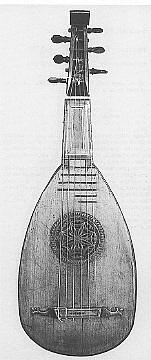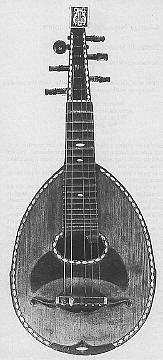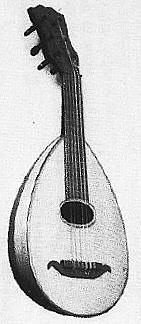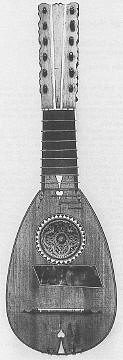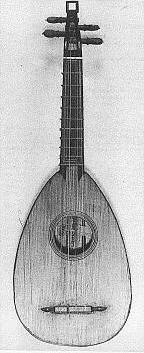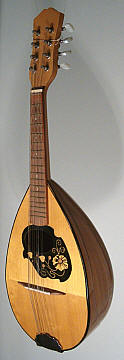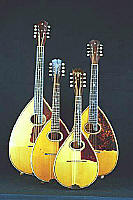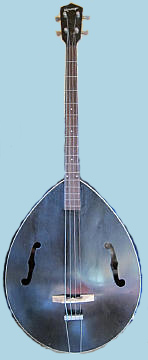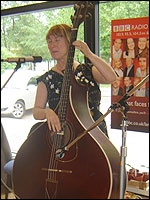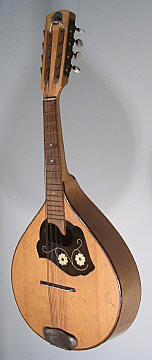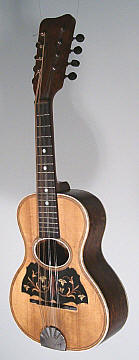| mandolins | ATLAS of Plucked Instruments |
| •
HOME • about • collection • books • index • links • lutes • guitars early • guitars modern • mandolins • cittern • banjos • steelguitars • miscellaneous • Europe West • Europe East • Europe South • Africa • Middle East • Central Asia • India • Far East • S.E. Asia • America N • America C • America S
|
mandolins On this page you will find the instruments of the mandolin
type, with their much confusing names; therefore I am not sure that
all names here are correct. First the historical gut-string mandolinos, starting with the gittern from the Middle Ages, to the 1900s - when they more or less disappeared. Then follows the separate variety of steel-string mandolins,
with a variety of names. Related instruments are the steel-string
cittern,
which you can find on the next page. |
| top | mandolinos | |||||||||||||||
|
gittern
The gittern is a small medieval lute-like instrument. It can be recognized on old pictures by its usually smaller size, a carved body, and a sickle shaped tuning head. Other spellings are : guittern or quintern. The gittern is carved from one block of wood,
with a thin wooden front and a sickle shaped peghead. The soundhole
is covered with a rosette (as were all early instruments) usually with
delicate wood/ parchment cuttings. Although flush with it, the fingerboard
is usually made of a different wood from the front. The frets are tied-on
gut. It has 3 or 4 courses of gut strings which could be tuned
like d' g' d'' g''.
|
|||||||||||||||
| top | ||||||||||||||||
|
mandore
(also another general name for the gut-string
mandolinos) During the Renaissance the
gittern changed : from a carved body to a small lute-like body
(made of staves). It resembles very much a small lute, with a carved
rosette, bridge glued to the front, fingerboard flush with the front
and tied-on gut frets. Examples in museums show a wide variety in body
shape. In France this instrument was called mandore
and in Italy mandola.
Note that the name mandola was later also used for a larger size mandolin and that the name mandore later was used for a French mandolino. And in the 18th century in Germany a large lute would be called mandora (or gallichon).
|
|||||||||||||||
| top | ||||||||||||||||
|
(ar)mandolino
From around 1650s the mandolino developed from the mandore. It is a smaller version of it. Sometimes it is called pandurine or armandolino (after the shape of almonds), and often baroque mandolin (to make clear the difference with the normal mandolin). In general : a mandolino has a small slender
lute-like body with a sickle-shaped tuning-head (ending in a square)
with pegs from both sides.
|
|||||||||||||||
| top | ||||||||||||||||
|
Milanese mandolino From around 1750s the mandolino became a bit
larger and had only 6 single strings. To set it aside from the double-stringed
mandolino this single-string instrument is nowadays called
the Milanese mandolino. It has 6 gut strings or courses, tuning : g b e' a' d" g". It was played with the fingers, or sometimes with a plectrum. |
|||||||||||||||
| top | ||||||||||||||||
|
Lombardic mandolin From the end of 19th century the Milanese mandolin changed into the mandolino Lombardo (also called mandore) : the body became more rounder, and it got a raised fingerboard, with metal frets. Often there is a scratch-plate between soundhole and bridge. The soundhole is often oval, and without a rosette. The peghead is still sickle shaped (ending in a flat ending) and the bridge had moustaches like a baroque guitar. The 6 gut strings were still tuned like the old mandolino : g b e' a' d" g". The Lombardic mandolin was the last of the mandolinos and it became obsolete around 1900.
|
|||||||||||||||
| top | ||||||||||||||||
|
French
mandora
In France in the 19th century
another (small) lute-like instrument developed, looking much like the
Lombardic mandolin (and comparable with a small German lute-guitar
- see lutes). The
tuning head was not sickle shaped, but flat with tuners from behind.
Notice that in the 18th century there was also a (large) lute-shaped instrument called mandora, which (by accident ?) also had 6 courses/strings and a guitar-tuning (see lutes).
|
|||||||||||||||
| top | mandolins | |||||||||||||||
|
Genoese
mandolin
The Genoese mandolin appeared around 1780 and did not last long. It has a small lute-like body, with a fingerboard flush with the front, and a flat peghead, with the (12) pegs from behind. The frets are tied-on gut. The rosette is carved in the front or made of layers of parchment. The narrow bridge is glued to the front, but the strings run over it to small pins at the end of the body. The lower end of the front (from the bridge) is slanting down (like on the mandolin Neapolitan). It has a (usually rectangular) scratch-plate near the bridge. The 6 gut courses were tuned in guitar-tuning : ee aa dd' g'g' b'b' e"e".
|
|||||||||||||||
| top | ||||||||||||||||
|
Cremona
mandolin
The Cremona mandolin (sometimes also called Brescian mandolin) was developed around 1800 by the musician Bortolazzi, and did not last long. It has a small lute-like body, with a sickle-shaped head, ending in a square. The fingerboard is flush with the front, and it has tied-on gut frets. It often has a carved rosette and the bridge is glued to the front. It does not have a scratch-plate. The tuning of the 4 gut strings was like a Neapolitan
mandolin (or like a violin):
|
|||||||||||||||
| top | ||||||||||||||||
|
mandolin
Neapolitan In Napels, around the 1750s, the mandolin was developed, not as a continuation of the mandolinos, but more as a relative of the Turkish tanburs and buzoks. The earliest Neapolitan mandolins were still
different from our modern version. The mandolin has 4 double courses of metal strings,
tuned in the violin tuning : It was played with a plectrum. |
|||||||||||||||
| top | ||||||||||||||||
|
mandolin
(modern)
The mandoline neapolitan is nowadays the most popular mandolin. This mandolin exists in several different sizes (like a family), most of them are mentioned on this page. This one is the most often used size : the "soprano" mandolin. It developed around 1850 from the original Neapolitan mandolin, when better metal strings became available. The main difference is the raised fingerboard, with metal frets running higher up. The tuning pegs are replaced by tuning machines from the back of the flat tuninghead. The back of the body is made of thin wooden staves, glued
together at the joints to form a bowl, like the lute. The front is slanting
down from the bridge for re-enforcement against the pull of the metal
strings. It is played with a plectrum, often (especially in Italy) with a rapid tremolo to lengthen/bind the notes. For more information about different types of mandolins see CBOM.
|
|||||||||||||||
| top | ||||||||||||||||
|
Roman mandolin Originally these mandolins were made in the area of Rome, especially by Luigi Embergher (1856-1943), one of the top Italian mandolin makers. He introduced around 1890 some special features to get a very high class instrument, to make it possible for the mandolin to be accepted as an orchestral instrument. Starting from the modern Neapolitan mandolin, the body became slightly slender and the fretboard rounded, for fast playing. The fingerboard extents to almost over the soundhole, for very high notes on the e"-string. He used an slotted tuning head (with guitar-like tuning
machines), and for some of his models a mandolino-like sickle-shaped
head; a shape that for mandolins became known as the "Embergher
tuning-head". Instruments from Emberghers workshop included :
|
|||||||||||||||
| top | ||||||||||||||||
|
mandola or tenor mandola or tenor mandolin The mandola is originally the "alto" of the mandolin family. In mandolin-orchestras they normally use the bowlback shaped body. However nowadays the mandola is often also used in folk /celtic music and the body then resembles more the flat cittern-like shape. Also the F-style and A-style mandolins (see under) are available in mandola sizes. The mandola has a longer scale than the mandolin (about 450mm), and is usually tuned 7 tones lower : cc gg d'd' a'a' . When used in Irish folk music it can be tuned in a variety of tunings.
|
|||||||||||||||
| top | ||||||||||||||||
|
octave mandolin or octave mandola The octave mandolin (also called octave mandola) is another member of the mandolin family, and nowadays mainly used in Irish folk music. So although they are sometimes made with bowl-back bodies, most often you will see them with the flat cittern-like body. Some are even made in guitar-shape ! The scale is about 520mm, with a tuning one octave lower
than the mandolin :
|
|||||||||||||||
| top | ||||||||||||||||
|
mandocello
The mandocello is a large mandolin,
and part of the mandolin family. It may also be called : mandoloncello
or liuto cantabile. The scale is about 650mm (similar to a guitar),
and the tuning is one octave lower than the mandola : CC GG
dd aa. Sometimes only one C string is used. If there are 5 courses,
it is with an extra top course, tuned e'e'.
|
|||||||||||||||
| top | ||||||||||||||||
|
mando-bass The mando-bass was originally designed in the 1910's by the Gibson firm for use in large mandolin orchestras. It is still popular in the USA. The mando-bass has a teardrop shape, and a flat
front and back. The soundholes are f-shaped. Other models may have a
more mandolin-shape body, or a round soundhole. The mando-bass has 4 thick strings, that run over a loose bridge to a metal stringholder.
|
|||||||||||||||
| top | ||||||||||||||||
|
mandriola A mandriola is a mandolin with 4 triple-string courses (12 strings in total). The body can be with a bowl-back, but the back is often flat or slightly rounded. The mandriola was popular in the early 20th Century, and many were made in Germany. Some mandriolas have even 4x 4 strings (there is no special name for those instruments). The instrument has a relative in the Mexican folk music, where it is called tricordia (or trichordia or tricordio). Tuning can be with "low octaves", like Ggg dd'd' aa'a' e'e"e", or without any octaves, so : ggg d'd'd' a'a'a' e"e"e", which is sometimes confusingly called "high octaves". The mandriola is played like a normal mandolin, but gives a much fuller sound.
|
| top | |||||||||||
|
flat
back mandolin This mandolin
is (like all mandolins) of the same size as the neapolitan
mandolin. It does not have a lute-like back, shaped like a bowl,
but it is flat, or slightly rounded. The front is also flat, without
the slanting bit under the bridge.
|
||||||||||
| top |
|
||||||||||
|
bluegrass
mandolin or
f-style mandolin This special type of mandolin was designed in the early 20th Century by the Gibson factory USA, based on an archtop instrument. It became such a succes that the model is now standard and called : f-style or bluegrass mandolin (after the type of music for which it is most often used). The body shape is very a-symmetrical, but feels quite balanced anyway. The curl is usually made of solid wood. The front and back are arched and it has f-hole soundholes, all based on the original violin designs. The tuning head has also a scroll. The bridge is usually in two parts, the top half can be raised or lowered by two big screws. The sound is slightly jazzier than the round-back mandolins. |
||||||||||
| top | |||||||||||
|
A-style mandolin Another archtop with a special body designed by Gibson, which also became quite popular and therefore a standard shape. The body usually has f-holes, but some makers use a normal round soundhole instead.
|
||||||||||
| top | |||||||||||
|
mandolin Gelas
In the early 1920 the Frenchman Gelas designed a very special instrument, with a double top.
It seems that Gelas was just the designer, and although
his signature is both on the inlay paper and as stamp on the front,
the instruments were normally made under licence by other French makers.
They were made untill the 1970's. |
||||||||||
| top |
|
||||||||||
|
octofone
The Regal instrument factory designed around
1930 a very special instrument that they called an octofone
(sometimes spelled : octophone). The body shape of the octofone is quite special : a narrow
teardrop, with near the neck two small points. The back is flat. Over
the years many different models were made by Regal, but all with the
same general body shape. The 8 metal strings are in 4 courses, and run over a small loose wooden bridge to a mandolin-like stringholder at the edge of the body. The surviving vintage instruments often need some repair
work, as the original eight strings were apparently a bit too heavy
for the construction. For more information about the octofone see
JackWildwood.
|
||||||||||
| top |
|
||||||||||
|
mandolinetto
Not all mandolins have a lute-like shape : some look like a guitar, or like a banjo. This nice (small) guitar-shaped mandolin, was popular in UK and USA in the first part of the 20th century and for some reason became known as mandolinetto. It is made just like a small guitar (ukulele
size), usually with some fancy plectrum scratch-plate on the front.
The soundhole is often oval shaped. For more information about mandolinettos see
MinerMusic
.
|
||||||||||
| top |
|
||||||||||
|
mandolin banjo Not all mandolins are in lute-like shapes : some are even shaped like a banjo. This banjo body has a mandolin neck with strings in a mandolin tuning. It was mainly popular in the UK during the first part
of the 20th century. |
||||||||||
| top | |||||||||||
|
lyre mandolin or harp mandolin Some mandolins got an unusually body-shape, like those based on instruments made by the Larson Brothers in the USA during the early 1900. The extra arm was probably meant to get some more volume.
|
||||||||||
|
|



